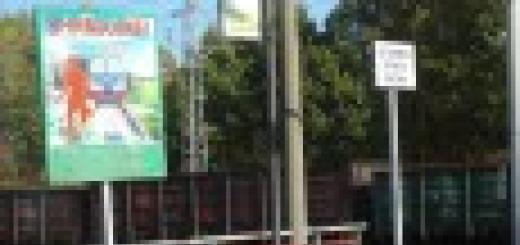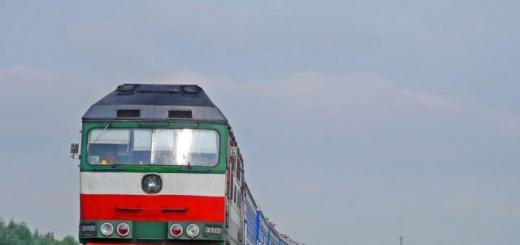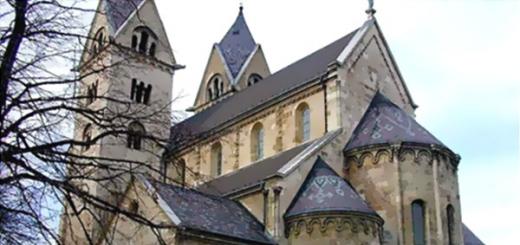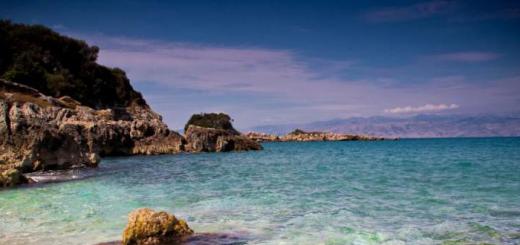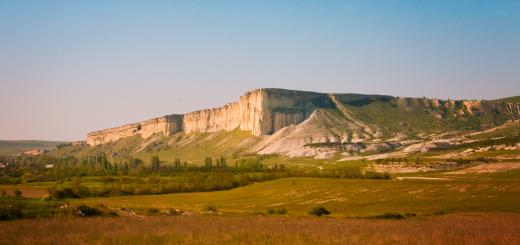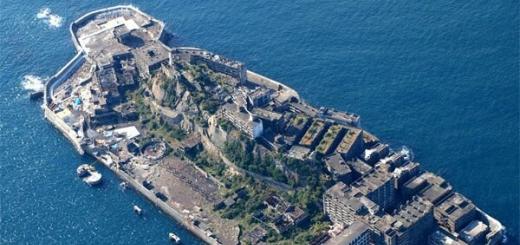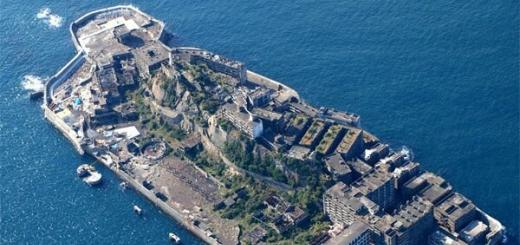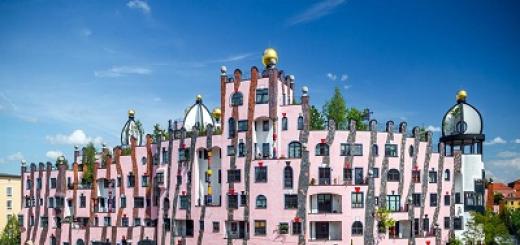Bath lake - Yakty-kul - in the Trans-Urals
The Trans-Urals attracts tourists with its original culture, rich history, but its main treasure is its extremely diverse natural landscapes. One of the main attractions is Lake Bannoye, or Yakty-kul, in the Abzelilovsky district of the Republic of Belarus, 45 km north-east of the village. Askarovo, 208 km (in a straight line to the north-west) from Ufa, 45 km from Beloretsk and 42 km from Magnitogorsk.
Lake Yakty-kul is located on the eastern foothills of the Krykty ridge. The relief of the territory is an alternation of 3-4 rows of low ridges and flat-bottomed depressions, stretching from the southwest to the northeast. The latitudinal valleys of the Maly Kizil and Analik rivers, as well as vast hollows and depressions occupied by swamps and lakes, divide the ridges into small ridges. The general lowering of the relief occurs from north to south and from west to east. The absolute marks of the surface of the ridges in the north are 600-660 m, in the south 550-600 m. The largest peaks are the mountains Ologor (530.2 m), Bagyshtau (565.5 m), Kutukai (664.1 m). The slopes of the ridges are rather gentle and well exposed. Such a variety and uniqueness of the relief is of great importance for the organization of recreation. At the same time, the dissection of the relief, the features of formation, the significance and safety of unique geological and geomorphological objects deserve special attention. In this territory, there is a strong dissection of the relief, which is the basis of landscape diversity, increases the aesthetics and comfort of the area.
![]()
![]() Three sisters. Trans-Urals. Photo artist Nail Galeev (Ufa)
Three sisters. Trans-Urals. Photo artist Nail Galeev (Ufa)
The hydrological network of the territory of the vicinity of Lake Yakty-Kul belongs to the basin of the Yangelka River - the main watercourse of the territory. Yangelka flows out of Lake Yakty-kul and, flowing in a wide trough-like valley, often with a swampy bottom, flows into Lake Chebarkul 24 km to the south. In addition to the sparse river network, there are three lakes in the study area. The largest is Lake Yakty-Kul with an area of 7.7 square kilometers. It is located in an intermountain basin east of the Krykty ridge. The greatest depth of its basin reaches 28 m, with an average depth of 10.6 m.
In the intermontane tectonic hollow, elongated in the meridional direction, 5 km south of Lake Yakty-kul, there is Lake Karagaz-Yura (Bezymyannoe I), and even further about 1 km to the south - Lake Kholyuktkul (Bezymyannoe II). They are separated by a slight rise in relief. By origin, both lakes are tectonic. Since the lakes are far from settlements and places of cattle grazing, their pollution by people and animals is excluded. Sapropel (medicinal freshwater mud) of these lakes meet all the requirements, both in nature and in sanitary terms. The sanatoriums "Yakty-kul" and "Yubileiny" are intensively using the resources of the lakes for medical and recreational purposes.
The climate of the study area, like that of the entire Bashkir Trans-Urals, is distinguished by a pronounced continental character. The main climate-forming factors are the amount of solar radiation, the circulation of air masses, the amount of precipitation, as well as the nature of the underlying surface. Bioclimatic indicators of the thermal regime of this territory are favorable for climatotherapy.
![]()
![]()
Seagull with fish. Trans-Urals. Photo artist Nail Galeev (Ufa)
The surroundings of Lake Yakty-kul are botanically and geographically part of the Sibai forest-steppe region of the ridge-small hummock foothills of the eastern slope. South Urals, birch forests are common here in combination with meadow and stony steppes.
Lake area - 7.7 km²; length - 4170 m, average width - 1880 m; maximum depth 28 m, average - 10.6 m, water volume - 81.7 million m³, catchment area - 36.3 km². The lake is located in the middle part of the Bashkir Trans-Urals between the peaks Kutukai (664 m), Karanyalyk (620 m) and the spurs of the Yamankaya ridge, 28 km north-east of the village of Askarovo, the regional center of the Abzelilovsky district of Bashkortostan, 45 km north of Magnitogorsk. The lake has a tectonic origin, it is the deepest body of water not only within the Trans-Urals, but throughout Bashkiria. The water in the lake is fresh and transparent. The banks are steep, steep in places, slightly sloping in the west. The Yangelka River, the right tributary of the Ural River, flows out of the lake.
Forest-steppe landscapes also prevail on the territory of Lake Yakty-Kul and its environs. The distribution of forest and steppe is uneven due to vertical zonation and climatic factors. The most widespread are birch forests, which, as a result of felling and fires, have replaced light coniferous forests in most of the range. Birch forests are widespread on slopes of different exposures, preferring more or less developed soils. The herbage is dominated by typical boreal species: reed grass, hedgehog, drupe, etc. In more humid habitats, the role of tall grasses increases: common bracken, white hellebore, meadowsweet. Aspen forests are similar to birch forests, but they occupy areas with more developed, rich and moist soils. Indigenous larch and pine forests are rare and have been preserved mainly closer to the summit areas on rough skeletal soils, where they compete with stony steppes. Old-time larch trees over 200 years old are often found among them.
![]()
![]()
Gold of a cloudy day. Trans-Urals. Photo artist Nail Galeev (Ufa)
The flora of the territory is very rich, it includes about 33% of higher vascular plants of the RB flora. The richness of the flora is due to the presence of mountainous relief, the special biogeographic position of the region - here the Asian and European flora, steppes and forests meet. Forest and meadow species prevail. A large occurrence of forest species in meadows is characteristic, and vice versa, meadow species in forests. This is an indicator of the great dynamism of the interaction of the “forest-grasslands” system. The steppe flora is very rich, where 78 steppe and 73 meadow-steppe species grow. It is distinguished by the significant presence of Siberian, often relict species that penetrated the Urals from the Pleistocene steppes. Many of them (cold wormwood, silk cinquefoil, prickly saxifrage) in RB are mostly distributed only on the eastern foothills of the Urals.
On the territory, the growth of 12 rare species included in the "Red Book of the Republic of Belarus" (2001) has been revealed. Among them there are 5 species from the "Red Data Book of the Russian Federation": thin-legged stiff-leaved feather grass, feather grass of Zalessky, lady's slipper, the rank of Litvinov. On the territory of the Yakty-Kul Lake area, a group of 6 relict species, mainly of Siberian origin, is represented: scythe onion, multi-stemmed peas, Siberian crumbs, Siberian phlox, prickly mountain grate, large-flowered foxglove. Among the endemic species, the following are especially rare: needle-leaved carnation, Iremel radiola. Animal world The territory of the lake is diverse, mainly Asian forms of animals dominate. Despite the influence of human economic activity, the species composition of animals is quite diverse. Relics - whitefish from Lake Bannoye, small southern stickleback, peled, and scoopers. Whitefish appeared here as a result of natural hybridization of the Chud and Ladoga whitefish, acclimatized in the 30s. XX century. Whitefish maintain their numbers through natural spawning. Lesser southern stickleback - the only representative of the order of sticklebacks found in the 1930s-1940s. academician L.S. Berg. Neither before, nor after, no one saw them in other lakes of Bashkiria.
Thus, Lake Yakty-Kul is characterized by the originality and uniqueness of its nature, therefore, it is necessary to establish a special regime for the exploitation of its surroundings and strictly observe it. To everyone who chooses the vicinity of Lake Yakty-kul as a place of rest; ample opportunities are provided to make fascinating travels and excursions, the list and selection of which is great and varied.
Author I.F. Adelmurzina Natural prerequisites for the development of tourism in the vicinity of Lake Yakty-Kul // Organization of the territory: statics, dynamics, management: Materials of the VII All-Russian scientific-practical conference. - Ufa.
2016-02-22T16: 35: 06 + 05: 00 lesovoz.77Domestic tourism RUSSIA Bashkiria, lake, South UralBannoe Lake - Yakty-Kul - in the Trans-Urals Trans-Urals attracts tourists with its original culture, rich history, but its main wealth is its extremely diverse natural landscapes. One of the main attractions is Lake Bannoye, or Yakty-kul, in the Abzelilovsky district of the Republic of Belarus, 45 km north-east of the village. Askarovo, 208 km (in a straight line to the north-west) ...lesovoz. 77 lesovoz antipkina-77 [email protected] Author TourLake Bannoye also has a peculiar toponym in the Bashkir language: it is sometimes called Yakty-Kul, which means "bright lake". Where did the name "Bannoe" come from? - This is related to the widespread story of how Emelyan Pugachev in 1774 ordered the army of his rebels to take a steam bath in this reservoir in front of the road to the Magnitnaya village - we cannot vouch for the reliability of this legend, but the name of the lake is really interesting and very peculiar.
Lake Bannoye is located in the Bashkir Trans-Urals, surrounded by three mountains - Kutukai, Karanyalyk and the Yamankaya spurs. It gives life to the Yanegelka River, the right tributary of the Urals itself. Bannoe is located in the Abzelilovsky district of our republic, about 28 kilometers northeast of the village of Askarovo - a local regional center - and 45 kilometers north of Magnitogorsk.
The area of the mirror surface of the Bannoye Lake is 7.7 km?, While the average depth is far from small - 10 meters, in some places, according to rumors, it reaches up to 30 m.Thanks to such impressive data, Lake Bannoe is considered the deepest body of water not just in the Trans-Urals, and the whole of Bashkortostan.
Rest on Banny
Rest on Lake Bannoye has long and firmly become one of the most popular leisure options for residents of our republic and its neighboring regions. Thanks to such popularity of local places, nature and the lake itself, a huge number of recreation centers, small hotels and children's camps immediately grew around. Many of the holidaymakers in the Bannoye area should have heard about the Yakty-Kul sanatorium, the Bannoye health resort (another name is Metallurg-Magnitogorsk) and the Abzakovo health and sports complex, which is also relatively close. Here are located such famous sanatoriums and rest houses as "Yubileiny", "Berezki", "Mayak" and many others. There are various camps for children on Banny - "Ural Dawns", "Mountain Gorge", "Skif" - the lists are endless.
All these establishments are for fun and comfortable rest on Banny, they are ready to provide tourists with educational excursions around the surroundings, and rafting on mountain rivers, and rock climbing lessons, as well as walks on mountain bikes, mountain bikes, go-karting and much more - who is in what.
Why is Lake Bannoe good? For starters, the water here is fresh, clear and clean (in any case, they try to follow this). It is for the purity of the waters that Bannoye got the name "Bright Lake". In addition, Lake Bannoe is an excellent fishing spot. There are plenty of underwater inhabitants here, and all thanks to the efforts of ecologists and fish farmers. Experienced fishermen promise you a solid catch in the early to early morning (from 4 am to 10 am - the greatest bite) and near the steep banks. By the way, steep shores are almost everywhere here, except for the western side of the lake, where they are gentle. Rumor has it that local fish bite on almost everything, which is probably why there are usually up to 100 thousand amateur anglers on Lake Bannom a year - this is a reason to show you your skill and luck.
Even in winter, this lake does not become quieter and more deserted, as the nearest ski centers open their doors. So do not be surprised when you hear a statement that someone is going to rest on Lake Bannoe in the midst of winter. All health centers here with good service and a solid list of services, which means that there is no shortage of vacationers in Bannoe.
Please also keep in mind that since 1965, Lake Bannoe has been a natural monument and, according to its status, is protected by law. All holidaymakers should show respect for the beauty of these places and, if possible, not pollute the territory of the lake.
Rest on Lake Bannoe can result in different amounts for tourists. Savages, of course, have the opportunity to find quiet surroundings, which are far from tourist centers and hotels, and spend their time on Banny for free. Lovers of comfortable rest will be able to choose a base for their money and their liking. The average price of a day at the recreation centers of Bannoye is about 1200 rubles. per person, but many institutions practice contractual payment, so there is a chance to save money, and vice versa. By the way, prices on weekdays at most recreation centers are lower than on weekends.
From Ufa to Lake Bannoe
In order for Ufa residents to enjoy their vacation on Banny, they will need to take a route to Magnitogorsk. There can be no problems with access to this city, because even the bus service with it operates without interruption. From Magnitogorsk to Lake Bannoye, about 40-45 km, we pass them in the direction of the city of Beloretsk. Sooner or later you will reach the Novo Abzakovo station and pass the Rest House - and there any mongrel will point you in the right direction to the Bannoe Lake.
Do you know why one of the most beautiful lakes in the Southern Urals is called that way? This is our note.
Lake Bannoye is located in the middle part of the Bashkir Trans-Urals between the peaks Kutukai (664 m), Karanyalyk (620 m) and the spurs of the Yamankaya ridge, 28 km. northeast of the village of Askarovo, the regional center of the Abzelilovsky district of Bashkortostan, 45 km north of Magnitogorsk.
The first names given locals lake - Mauzzy - "bottomless, insatiable" or Ajahaly, which means "lake in which the monster lives." This name was associated with a legend that arose among the people, and is chilling to this day. Legends that have come down to us from time immemorial tell that in immemorial antiquity the lake was surrounded by an impenetrable forest thicket, and ruled in it terrible monster, regularly spoiled the water in a huge reservoir. The animals were afraid to go to the watering hole on the shores of the lake - his master was terrible in anger. Even the birds flying over the lake were drawn into the womb by the monster.
Another name of the lake known since the 16th century, Bashkir, is Yakty-kul, from the Bashkir "yakty" - "light". Thus, in translation from Bashkir it is “ Bright lake».
Popular rumor links the occurrence modern name lakes - BATHROOM - with Emelyan Pugachev. According to legend, in 1774, the frightening army stopped here to wash, arranged a kind of "Bath day". The name "Bannoe" has been known in written sources since the beginning of the 18th century, and it was under this name that the lake became known and popular among vacationers. However, the root name has not disappeared either - on the southwestern coast there is a village called Yakty-Kul, and in all media and reference books in the Bashkir language, the lake appears under its "true" name.
Emelyan Pugachev
HOW TO GET THERE, WHERE IS IT LOCATED?
The lake can be reached by car or bus from Magnitogorsk, Sibay or Beloretsk. From Yekaterinburg and Chelyabinsk you should go through Plast and Magnitogorsk. From Ufa - via Beloretsk. From Orsk and Orenburg - via Sibay. The roads, although not wide (usually a lane in each direction), are in excellent condition. 
Sanatorium Yakty-Kul. Treatment
The main treatment factors the sanatorium has a favorable climate (mountain air, forests, lakes) and silt-sapropelic mud of Lake Bezymyannoe-1.
Silt-sapropel mud has anti-inflammatory, immunomodulatory, analgesic and resorption effects. The source of sapropel mud is Lake Bezymyannoe-1, which is 4 kilometers from the sanatorium. Sapropel is rich in organic compounds, which include the remains of aquatic vegetation and phyto-zooplankton. Vacationers take all the procedures in the mud baths, equipped with modern equipment in the form of mud wraps, applications. The radon baths used here also have enormous healing potential (analgesic, anti-inflammatory and sedative properties).
The range of applications is wide - from diseases of the spine, joints, muscles, peripheral nervous system to the treatment of gynecological diseases. Mud baths, wraps, tampons in combination with radon, pine-pearl, sea baths, with various types of massage, including gynecological, lead to the fact that with an improvement in gynecological diseases, up to 85 percent of women are prescribed. And a third of women suffering from infertility get the opportunity to become pregnant for the first time. Mud procedures also solve "male problems", so married couples often come for treatment.
Hydrotherapy- an integral part of the complex part of complex therapy for many diseases, which are used in "Yakty-Kul". In the bathroom department there are baths at the guests' disposal for taking coniferous, sea, coniferous-pearl baths. Used sea, aromatic baths, underwater massage shower, Charcot's shower, ascending, circular, turpentine, cascade.
In addition to the natural healing factors of the microclimate, the sanatorium is widely used physiotherapy treatments: microwave therapy, magnesium therapy, amplimpulse, franklinization, darsonvalization, electrophoresis of medicinal substances and healing mud, quartz-ultraviolet irradiation, laser, phototherapy, electrosleep, Andro-Gin apparatus.
Patients with cardiovascular disease are prescribed treatment dry carbon dioxide baths... The complex uses physiotherapy procedures.
Speleo camera, where they heal with the beneficial effects of a unique salt climate, an excellent remedy for the treatment of the bronchopulmonary system, allergies and a number of skin diseases. Speleotherapy can be safely called natural, natural, not causing complications.
Are applied various types of massages: classic, acupressure, segmental, gynecological, hydromassage, apparatus massage (massage chair, apparatus "Maruataka").
V phytobar You can always pamper yourself with delicious infusions of medicinal herbs that are collected in ecologically clean areas of Bashkortostan. Vacationers can also use the services of a dental office.
Resort and medical specialization of the sanatorium "Yakty-Kul":
- musculoskeletal system and connective tissues;
- genitourinary system (kidneys and urinary tract);
- gynecology and urology (the sanatorium has natural therapeutic factors sufficient in terms of therapeutic effect, modern physiotherapy technologies and is specialized in the rehabilitation treatment of gynecological patients.)
- female and male infertility;
- nervous system;
- respiratory system;
- circulatory system;
- wellness programs.
The pool, sauna and solarium are located in the medical building of the Yakty-Kul sanatorium.
   |
Services
Service:
Beach, summer cafe "OTDYKH", children's room, playground, cinema, gym, billiards, parking, grocery and manufactured goods store, Sberbank ATM, Amigo Terminal, rental (bike, ski), pharmacy. There is a paid Internet connection (in zones) 150 rubles - 5 hours
    |
Entertainment:
Rental (snowmobiles, skis, bicycles, skates), private beach, boat station, table tennis, pool with sauna, volleyball, cinema, cafe, fitness room, billiards, small restaurant, dance floor, library, winter garden, winter and summer fishing ...
Excursions:
1. Historical and archaeological center "Arkaim" (ancient settlement Arkaim, Mount Shamanka, Mountain of Love, Museum "Man and Nature");
2. Hiking to the top of Karangylyk mountain (overlooking the next 10 lakes);
3. Ski complex "Abzakovo" ( ski slopes with chair lifts, water park);
4. Aquapark "Waterfall of Miracles" (Magnitogorsk);
5. "Magnitogorsk - the city of metallurgists" (Magnitnaya Gora, First Tent, Pugacheva Gora, art gallery, monuments and monuments);
6. Ski center"Metallurg-Magnitogorsk".
Upon check-in, documents are required: For adults: passport, spa card, exchange voucher (if the voucher was purchased through a travel company). For children under 14: birth certificate. If available: certificates of vaccinations and epidemiological conditions. For vouchers under the "Pensioner" program: a pension certificate, or another document confirming the right to purchase vouchers under the "Pensioner" program.
Between the steep spurs of the mountains, there is a lake of amazing beauty - Yakty-Kul. The purest, transparent fresh water, crystal mountain air, amazing nature, wonderful variety of plants and animals - for the extraordinary characteristics of Yakty-Kul and its surroundings are recognized natural monument and are protected by the state. The location of the lake is the Republic of Bashkortostan.
Scientists cannot name exact age lakes, but along the shores of the reservoir, archaeologists discovered the sites of ancient people. Formed as a result of the subsidence of the earth's crust, the lake has an area of 7.7 km². Its length is just over 4 km, width is about 2 km. Like any mountain body of water, Yakty-Kul is distinguished by great depths, in some places reaching 30 m. The lake is "fed" by mountain streams, because of this, the water in it is always cool. One river flows out of the reservoir - the nimble and nimble Yangelka.
Legends of Yakty-Kul lake
 This colorful place is shrouded in secrets. There are legends about the name of the reservoir. The lake has several names by which it was called at different times. Some of the oldest surviving ones are Mauzda and Ajahaly. Mauzds among the Turkic peoples are a formidable mythical creature, meaning "bottomless, insatiable." And Ajahaly is a terrible monster, which, according to legend, once lived in a reservoir, messed up the surface of the lake and scared to death the animals and desperate fishermen who dared to fish there.
This colorful place is shrouded in secrets. There are legends about the name of the reservoir. The lake has several names by which it was called at different times. Some of the oldest surviving ones are Mauzda and Ajahaly. Mauzds among the Turkic peoples are a formidable mythical creature, meaning "bottomless, insatiable." And Ajahaly is a terrible monster, which, according to legend, once lived in a reservoir, messed up the surface of the lake and scared to death the animals and desperate fishermen who dared to fish there.
Since the 16th century, the lake has been called Yakty-Kul, which means "bright lake" in Bashkir. Russians have a different name in everyday life - Bannoe. An interesting legend is connected with it. During the campaign led by Yemelyan Pugachev, the rebellious army halted at this place. Before an important battle, Pugachev ordered the soldiers to wash themselves thoroughly with clean lake water. In those ancient times, the process of ablution was called "bathing". This is where the second name of the lake came from. This is how it is indicated on the cards.
 One of the most beautiful lakes in the Southern Urals, Yakty-Kul, invariably attracts thousands of people. You can have a wonderful rest all year round... In summer, everyone rushes to the beach, and in winter, conquer the snow-capped mountain slopes. In this luxurious place with amazing nature and crystal water are located rest houses and resort complexes. The Yakty-Kul sanatorium is especially popular. The climatic and mud clinic not only energizes and restores strength, but also relieves many ailments.
One of the most beautiful lakes in the Southern Urals, Yakty-Kul, invariably attracts thousands of people. You can have a wonderful rest all year round... In summer, everyone rushes to the beach, and in winter, conquer the snow-capped mountain slopes. In this luxurious place with amazing nature and crystal water are located rest houses and resort complexes. The Yakty-Kul sanatorium is especially popular. The climatic and mud clinic not only energizes and restores strength, but also relieves many ailments.
Throughout the Urals, the glory of the lake is thundering as a wonderful fishing place. Fishing in Yakty-Kul is great. In addition to the originally inhabiting fish species, whitefish and stickleback were launched into the reservoir at the beginning of the last century, which took root well. All lovers of "quiet hunting" note a huge number of very different fish in the lake, including very large - more than 2 kg - specimens, and an excellent bite. A powerful fish population is one of the indicators of the ecological purity of the area.

